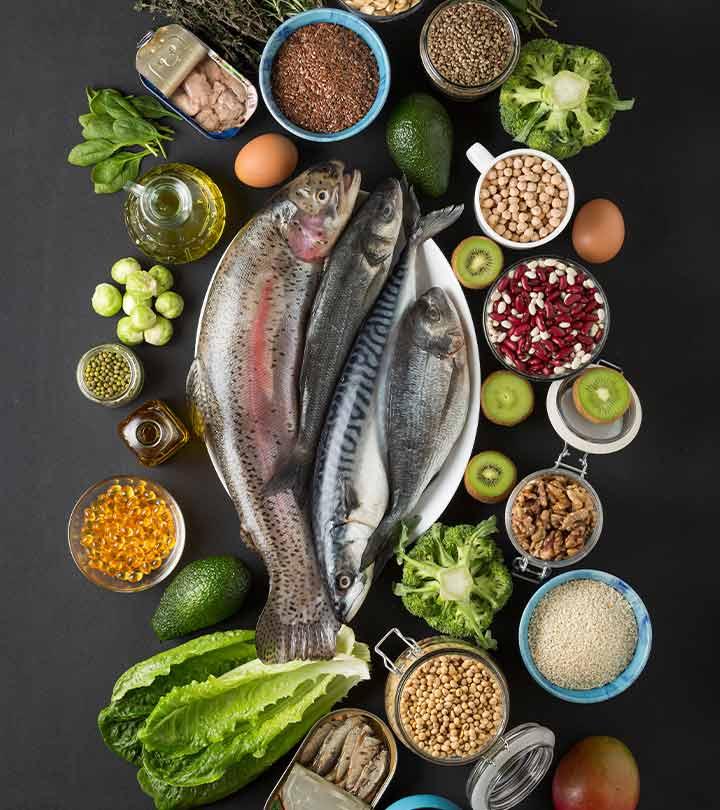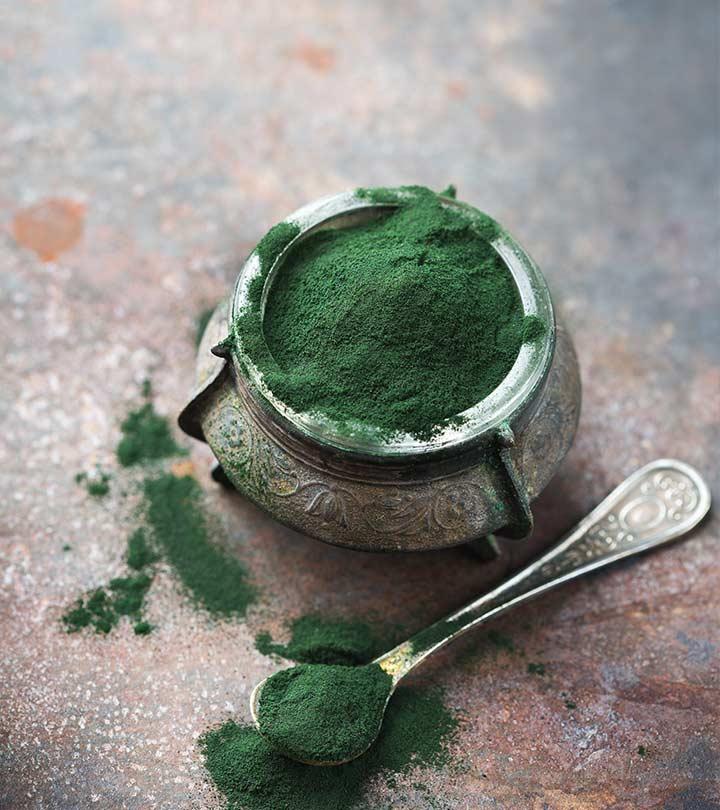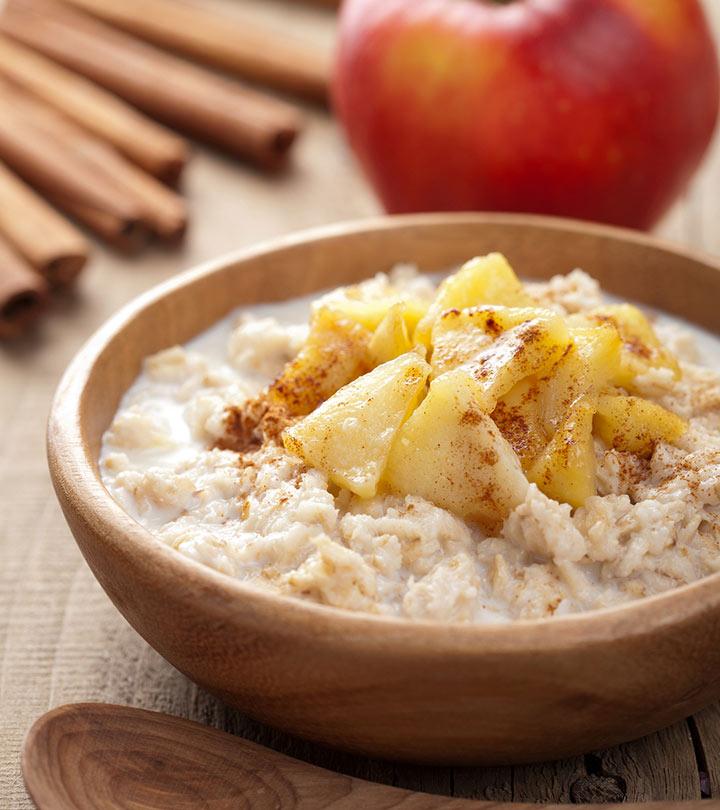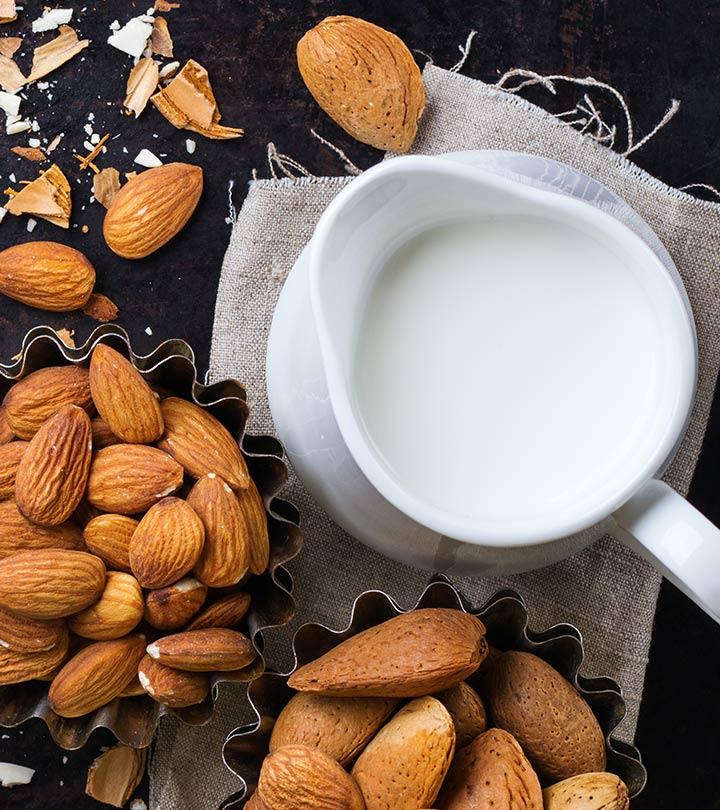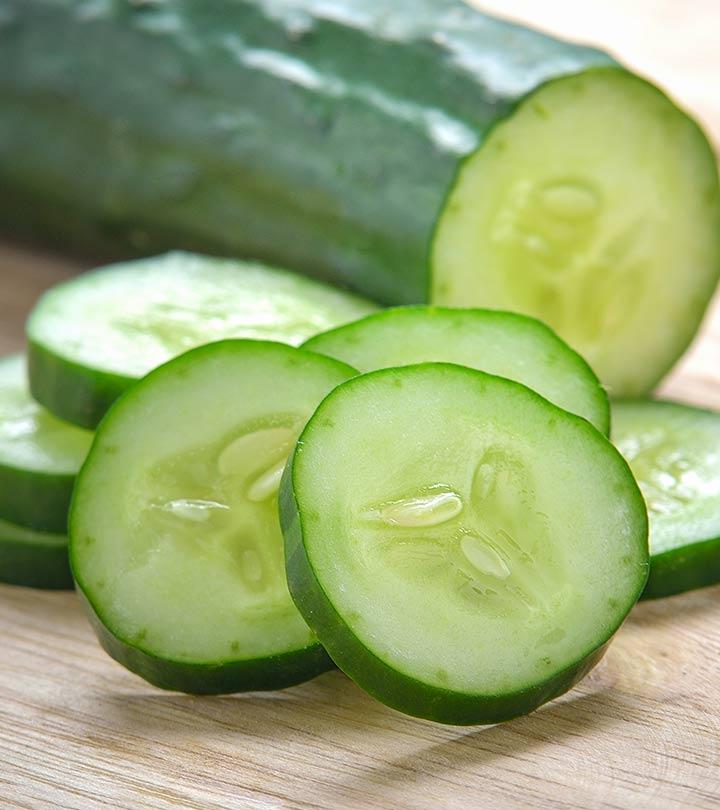7 Health Benefits Of Jicama You Must Know
Packed with fiber and healthy carbs, this root veggie is sure to boost your gut health.

Image: Shutterstock
Jicama is widely used in Mexican cuisine. Jicama’s benefits are attributed to its exceptionally rich nutrient profile. Its nutty and sweet flavor makes it very popular among consumers. You can also call this root vegetable yam bean, Mexican turnip, or Chinese potato. It is scrumptious when eaten raw or cooked. There are many health benefits to eating this low-carb vegetable. We will tell you about jicama’s benefits, how it can be eaten, and some recipes you may enjoy. Keep reading.
In This Article
What Is Jicama?
Jicama is a starchy root vegetable with thick, brown skin and is often compared to potatoes in terms of starch content. It has white, crunchy, and juicy flesh and is native to Mexico and Central and South Americas. Jicama contains carbohydrates, dietary fiber, 80%-90% water, and trace amounts of protein and lipids. It has low levels of saturated fat and sodium.
In a survey conducted on 378 participants (175 men, 203 women) about yogurt consumption, 97.35% expressed interest in having natural jicama yogurt, while 2.65% did not. Among those who buy yogurt, 51.06% do so for its nutritional value, 35.19% for a healthier lifestyle, 7.41% based on a doctor’s recommendation, and 6.35% for other reasons.
 Trivia
TriviaHere is the complete nutrient profile of Jicama.
Nutrient Profile Of Jicama
A hundred grams of raw jicama contains (1):
Energy | 38 kcal |
Protein | 0.72 g |
Total lipid (fat) | 0.09 g |
Ash | 0.3 g |
Carbohydrate, by the difference | 8.82 g |
Fiber, total dietary | 4.9 g |
Sugars | 1.8 g |
Calcium | 12 mg |
Iron | 0.6 mg |
Magnesium | 12 mg |
Phosphorus | 18 mg |
Sodium | 4 mg |
Zinc | 0.16 mg |
Copper | 0.048 mg |
Manganese | 0.06 mg |
Vitamin C | 20.2 mg |
Folate | 12 μg |
 Fun Fact
Fun FactAll these nutrients and antioxidants in jicama can benefit your overall health in multiple ways. Let’s take a look.
Health Benefits Of Jicama
1. Reduces The Risk Of Diseases
The fiber in jicama can help with weight management and reduce inflammation, depression, and the risk of cardiovascular diseases (2). It contains calcium, phosphorus, magnesium, and iron, which are important for improving bone strength. They also serve as co-factors for many enzymes for carrying out various chemical reactions in the body.
Iron maintains the oxygen-carrying capacity of the blood (3). Vitamin C in jicama is an excellent antioxidant to boost the immune system and prevent infections and diseases (4). Vitamin C is also a superfood for the adrenals and probably the most important vitamin in times of stress (5).
2. Reduces The Risk Of Congenital Abnormalities
Folate plays an important role in the development of the fetus, and jicama contains 4% of the recommended daily value of folate. During pregnancy, inadequate folic acid intake may lead to congenital heart defects, obstructive urinary tract anomalies (conditions affecting the kidneys and urinary tract structure), limb deficiencies, orofacial clefts, and congenital hypertrophic pyloric stenosis (blockage of the gastric passage).
Sufficient intake of folate can help reduce the risk of these congenital anomalies. Adequate folic acid intake in adults is associated with a reduced risk of cardiovascular disease and some cancers (6).
3. May Help In Diabetes Management
Jicama is rich in inulin, a soluble fiber that reduces postprandial blood glucose levels. In addition, it has a low glycemic index making it a great choice for anyone struggling to balance their blood sugar (7). Jicama can also improve insulin sensitivity by inhibiting gluconeogenesis in the liver and maintaining plasma insulin levels (8). This may help in diabetes management.
4. May Reduce The Risk Of Cancer
Animal studies have shown that inulin has potential anticarcinogenic properties and significantly reduces the risk of colon cancer. In human cells, inulin-derived metabolites inhibit tumor cell growth and reduce other risk factors of cancer (9). Jicama extracts also contain inulin, which may have anti-cancer properties. However, more research is required to substantiate this claim.
5. Improves Bowel Movement
The insoluble fiber in jicama may help regulate bowel movements and reduce the risk of associated conditions like constipation, hemorrhoids, and other gastrointestinal conditions. Dietary fiber also lowers the risk of developing coronary heart disease, obesity, stroke, hypertension, and ulcers (10).
6. May Improve Skin And Hair Health
Jicama contains vitamin C, an antioxidant that improves skin and hair health when consumed. It prevents free radical damage to slow down premature aging, reduce hair loss, and promote healthy hair growth (11), (12), (13).
This vegetable is commonly eaten raw and has a slightly sweet, watery, and apple-like crunch. You can peel and eat jicama as it is or try these recipes at home.
7. May Act As A Prebiotic
Jicama, a root vegetable, serves as a good prebiotic source due to its high content of inulin fiber. This soluble fiber may act as a prebiotic, promoting the growth of beneficial gut bacteria like Bifidobacteria and Lactobacilli. Inulin remains intact through the digestive tract, reaching the colon undigested, where it serves as fuel for probiotics, aiding in digestive health and enhancing the gut microbiome’s diversity. In a study conducted using jicama extract as a prebiotic, it was found that it may enhance the effect of probiotics and has anti-diabetic potential (14). Incorporating jicama into salads, slaws, or as a crunchy snack provides prebiotic benefits, supporting a healthy gut environment and potentially contributing to improved overall well-being.
Check out some of the lip-smacking recipes in the section below and enjoy the goodness of jicama.
How To Cook And Eat Jicama: 3 Delicious Recipes
1. Baked Jicama Fries
What You Need
- 1 medium-sized jicama (cut into finger chips)
- 1 tablespoon of avocado oil
- ½ teaspoon of turmeric
- ½ teaspoon of garlic powder
- ½ teaspoon of onion powder
- ½ teaspoon of sea salt
- ¼ teaspoon of black pepper
Method
- Preheat oven to 400°F.
- Boil the jicama slices for 8-10 minutes.
- Drain the water and allow the slices to dry.
- Put them into a large bowl, add oil, turmeric, garlic powder, onion powder, salt, pepper, and mix.
- Spread the fries onto a baking sheet.
- Bake for 30 minutes and serve with guacamole or cheese dipping.
2. Grilled Chicken With Jicama Avocado Salsa
What You Need
- 1 small jicama
- 3 tablespoons of lime juice
- ¼ cup of freshly chopped cilantro leaves
- 1 finely chopped medium shallot
- 1 diced avocado
- 4 thin chicken cutlets
- 1 tablespoon of olive oil
- 1 teaspoon of smoked paprika
Method
- Finely dice the jicama and combine it with lime juice, cilantro, and shallots.
- Add the avocado, salt, and mix. Keep the salsa aside.
- Preheat grill pan to medium-high.
- Toss the chicken with the oil, smoked paprika, salt, and pepper in the pan.
- Grill the chicken for 2–4 minutes on each side.
- Serve it with salsa.
3. Crunchy Jicama Curry
What You Need
- 1 medium-sized diced jicama
- 2 medium-sized onion (chopped)
- 2 medium-sized tomatoes (chopped)
- 1 teaspoon of olive oil
- ½ tablespoon of turmeric
- ¼ tablespoon of coriander powder
- ¼ tablespoon of red chili powder
- ¼ tablespoon of cumin powder
- 1 cup of milk
Method
- Add olive oil to a pressure cooker and sauté the onion for 5 minutes.
- Add turmeric, jicama, and the rest of the ingredients and mix well.
- Pressure cook it for 15 minutes.
- Add milk and cook for another five minutes.
- Serve hot with rice.
Here in this blog, the blogger, fascinated by the exotic jicama vegetable, shares the excitement of preparing a delicious salad with it. Describing the unique taste, she writes, “To me, it tastes like radish, pear, potato all at the same time. There is a nice sweetness and crunch to it which make the vegetable so exciting (i).”
Jicama is often compared with potato as they look similar and contain starch. However, both are different.
Jicama Vs. Potato
Jicama | Potato |
Raw jicama has a slightly sweet and nutty flavor. | Raw potato has a bitter taste. |
A hundred grams of jicama contains 38 calories. | A hundred grams of potato contains 79 calories. |
It is a low-carb veggie (8.2 g of carbs per 100 g). | It contains more carbs than jicama (18.1 g of carbs per 100 g). |
Jicama is safe to consume. However, you may experience side effects if you are allergic to it.
Side Effects Of Jicama
The seeds and stems of the jicama plant contain rotenone, a type of fatal toxin (15). Hence, avoid consuming any other parts of the jicama plant.
Jicama is safe when consumed in moderation. It contains fiber, which may cause the minor gastrointestinal issues mentioned below if consumed in excess:
- Abdominal pain
- Bloating
- Diarrhea
- Constipation
If you experience any of these side effects, drink plenty of water to relieve them. If the symptoms persist for more than two days, consult your doctor.
In rare cases, jicama may cause allergic reactions like:
- Itchy tongue
- Mild throat pain
- Stomach irritation and cramps
You may develop the symptoms within 30 minutes to two hours after consuming jicama. If you experience these, avoid consuming it, and consult a doctor for treatment.
Jicama is a low-carb root vegetable with an exceptional nutritional profile. It is rich in water, fiber, carbs, and proteins. And these nutrients are responsible for many benefits of jicama. The consumption of jicama may reduce the risk of cardiovascular diseases, inflammation, and congenital abnormalities, help in diabetes management, act against cancer cells, and improves bowel movement. In addition, it may slow down signs of premature aging and promote hair growth. However, consuming excessive amounts of this veggie may cause abdominal pain, bloating, diarrhea, and constipation. Hence, limit your portions to enjoy its benefits.
Frequently Asked Questions
How much jicama can you eat a day?
You may consume a cup (130g) of sliced jicama every day. It contains just under 50 calories and 6.4g of fiber, which helps you meet your daily requirements.
Is jicama alkaline or acidic?
Jicama is alkaline.
Key Takeaways
- Jicama contains calcium, phosphorous, and iron, which improve bone health.
- It also has decent amounts of folate, which reduces the risk of congenital abnormalities.
- Jicama is also said to reduce the risk of cancer and aid in promoting skin and hair health.
- People who are sensitive or allergic to jicama may experience abdominal pain and bloating.
Discover the wonderful health benefits of jicama and the miraculous effect it has on your body. This video shows the nutritional wonders of this versatile vegetable that can revolutionize your approach to wholesome eating. Click play to see how!
Personal Experience: Source
StyleCraze's articles are interwoven with authentic personal narratives that provide depth and resonance to our content. Below are the sources of the personal accounts referenced in this article.
(i) Jicama Is Probably the Most Exciting Vegetable & This Is How I Slice it For SaladReferences
Articles on StyleCraze are backed by verified information from peer-reviewed and academic research papers, reputed organizations, research institutions, and medical associations to ensure accuracy and relevance. Read our editorial policy to learn more.
- Yambean (jicama) raw
https://fdc.nal.usda.gov/fdc-app.html#/food-details/170073/nutrients - The Health Benefits of Dietary Fibre
https://www.ncbi.nlm.nih.gov/labs/pmc/articles/PMC7589116/ - Exercise and mineral status of athletes: calcium magnesium phosphorus and iron
https://pubmed.ncbi.nlm.nih.gov/7658944/ - Vitamin C and Immune Function
https://www.ncbi.nlm.nih.gov/labs/pmc/articles/PMC5707683/ - The importance of vitamin C in times of stress.
https://pubmed.ncbi.nlm.nih.gov/15666839/ - Folic acid for the prevention of congenital anomalies
https://pubmed.ncbi.nlm.nih.gov/9667396/ - The effect of low GI foods on blood sugar levels.
https://pubmed.ncbi.nlm.nih.gov/31374573/ - Jicama (Pachyrhizus erosus) extract increases insulin sensitivity and regulates hepatic glucose in C57BL/Ksj-db/db mice
https://www.ncbi.nlm.nih.gov/labs/pmc/articles/PMC4706093/ - Inulin-type fructans and reduction in colon cancer risk: a review of experimental and human data
https://pubmed.ncbi.nlm.nih.gov/15877900/ - Jicama (Pachyrhizus erosus) fiber prevents excessive blood glucose and body weight increase without affecting food intake in mice fed with a high-sugar diet
https://www.ncbi.nlm.nih.gov/labs/pmc/articles/PMC6702872/ - Vitamin C in Disease Prevention and Cure: An Overview
https://www.ncbi.nlm.nih.gov/labs/pmc/articles/PMC3783921/ - Topical Vitamin C and the Skin: Mechanisms of Action and Clinical Applications
https://www.ncbi.nlm.nih.gov/labs/pmc/articles/PMC5605218/ - The Role of Vitamins and Minerals in Hair Loss: A Review
https://www.ncbi.nlm.nih.gov/labs/pmc/articles/PMC6380979/ - Treating the Onset of Diabetes Using Probiotics Along with Prebiotic from Pachyrhizus erosus in High-Fat Diet Fed Drosophila melanogaster
https://pubmed.ncbi.nlm.nih.gov/35710863/ - Fatality after deliberate ingestion of the pesticide rotenone: a case report
https://www.ncbi.nlm.nih.gov/labs/pmc/articles/PMC1175899/
Read full bio of Silky Mahajan
Read full bio of Ravi Teja Tadimalla
Read full bio of Payal Karnik









